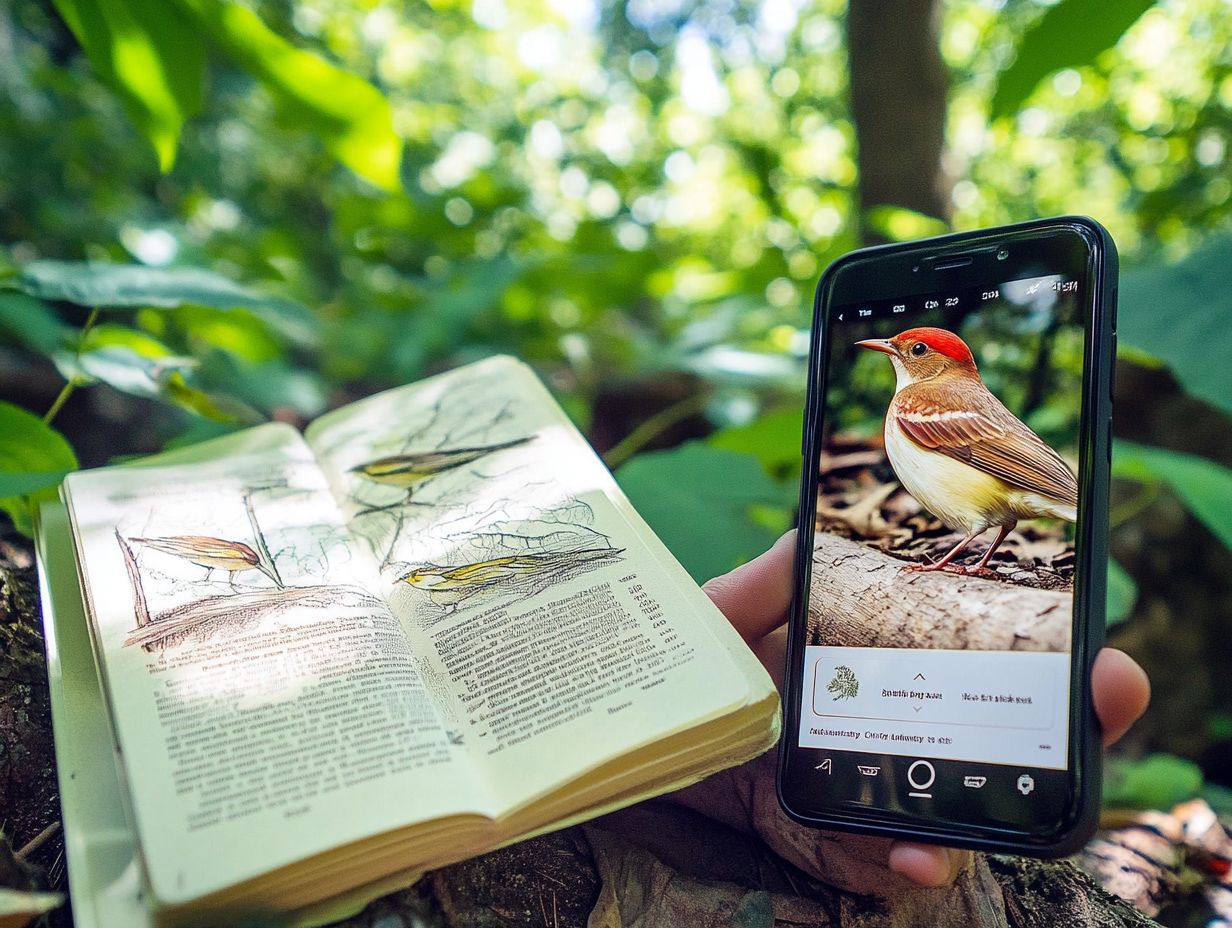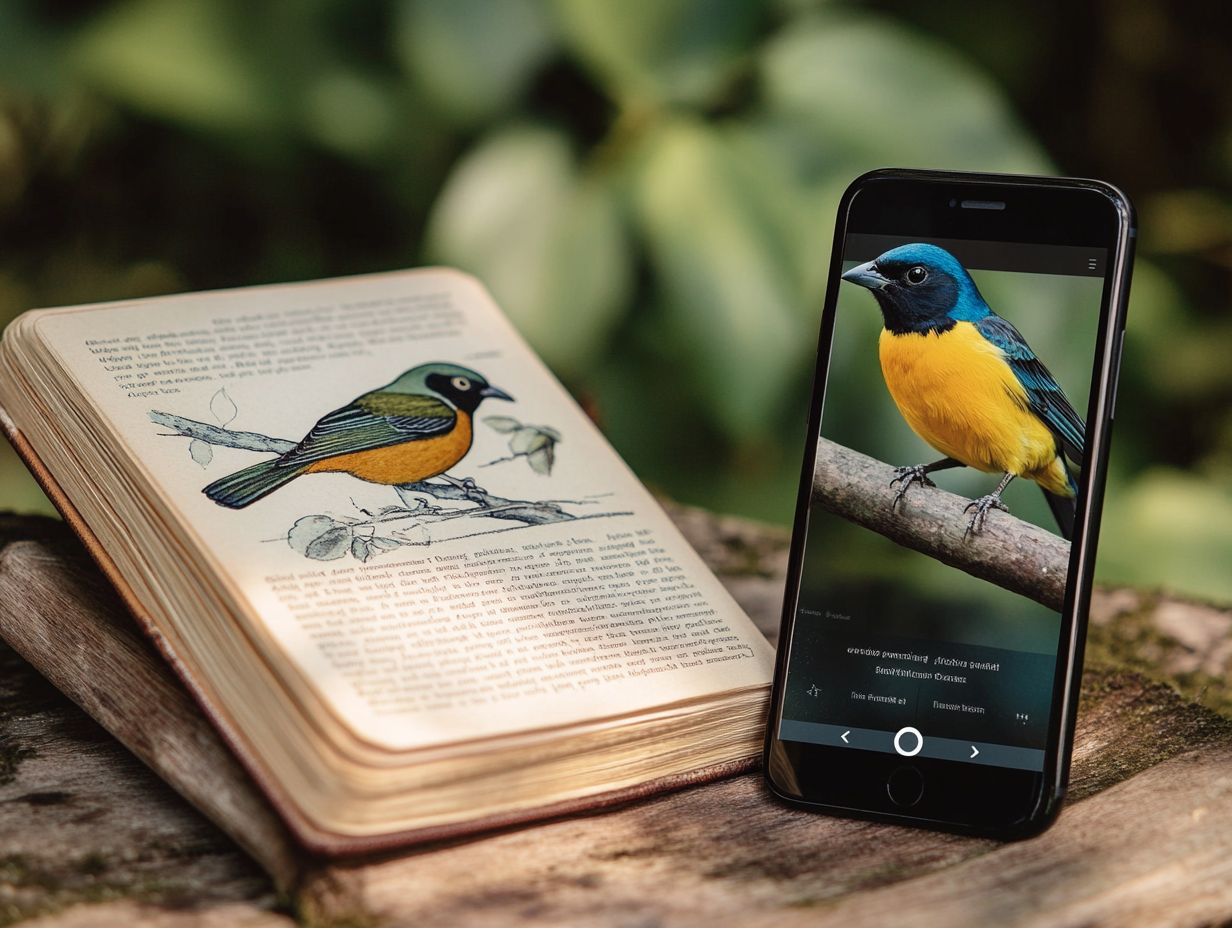Field Guides vs. Apps: Which is Better for Birding?
Birdwatching has blossomed into a cherished pastime for many enthusiasts. Selecting the right tools can significantly enhance your experience.
This article delves into two prominent choices: traditional field guides and contemporary birding apps. It examines their respective advantages and limitations. This will allow you to carefully consider the merits of tangible pages compared to the ease of digital technology.
By the conclusion, you will gain a clearer insight into which option aligns best with your unique birding style and objectives.
Contents
- Key Takeaways:
- Overview of Field Guides and Birding Apps
- Pros and Cons of Using Field Guides for Birding
- Pros and Cons of Using Birding Apps
- Potential Drawbacks of Birding Apps
- Factors to Consider When Choosing Between Field Guides and Apps
- Personal Preferences and Birding Goals
- Accessibility and Cost
- Final Thoughts and Recommendations
- Frequently Asked Questions
- What are field guides and apps used for in birdwatching?
- Which is more convenient to use in the field?
- Which provides more accurate and detailed information?
- What are the cost differences between field guides and apps?
- Which offers a better learning experience for beginner birdwatchers?
- Can field guides and apps be used together in birdwatching?
Key Takeaways:

- Traditional field guides are your trusted companions in the thrilling world of birding, providing a tangible and reliable resource. However, they may be limited in their ability to constantly update information.
- Apps provide convenience and accessibility, but they may lack the comprehensive and detailed information found in field guides.
- When choosing between field guides and apps, consider your personal preferences, birding goals, accessibility, and cost. Your best option depends on your needs and preferences.
Overview of Field Guides and Birding Apps
The realm of birding has undergone a remarkable transformation. It elegantly blends traditional techniques with the latest technology, improving your ability to identify birds.
Field guides and birding apps have become critical assets. They empower you to make precise observations across North America, Central America, and South America.
Whether you rely on trusted resources like the Audubon Bird Guide and Sibley Birds 2nd Edition or embrace forward-thinking smartphone apps like eBird and Merlin Bird ID, you can now navigate the avian world with unparalleled efficiency and enjoyment.
What are Field Guides and Birding Apps?
Field guides and birding apps are essential companions as you strive to refine your bird identification skills. They offer a wealth of information on various species.
Field guides, like the Audubon Bird Guide and Sibley Birds 2nd Edition, provide intricate illustrations and detailed descriptions. Birding apps such as eBird and Merlin Bird ID leverage user-friendly features and technology to elevate your birding experience.
Each resource boasts unique advantages. Field guides offer a deep dive into understanding and a tactile engagement with stunning illustrations, making them ideal for those who appreciate the artistry of avian life.
On the flip side, birding apps enhance your adventure by allowing you to log your sightings, access real-time information, and connect with a vibrant community of fellow enthusiasts.
This harmonious blend of traditional printed resources and modern digital tools gives you the power to choose your preferred identification method. This ensures you are well-equipped whether you re out in the field or enjoying the wonders of birdwatching from the comfort of your home.
Pros and Cons of Using Field Guides for Birding
Utilizing field guides for birding offers a distinct combination of advantages and drawbacks. This creates a nuanced experience for those eager to identify and observe various avian species.
Traditional resources, such as the Audubon Bird Guide and Sibley Birds 2nd Edition, provide detailed illustrations and trustworthy information. However, they may fall short in terms of immediate accessibility and interactive features that modern technology offers.
Recognizing these pros and cons is crucial for anyone aiming to elevate their bird identification journey.
Benefits of Traditional Field Guides
Traditional field guides, like the Audubon Bird Guide and Sibley Birds 2nd Edition, offer a treasure trove of benefits that elevate your birding experience to new heights. These guides come packed with stunning visuals and detailed information, making them critical for accurately identifying birds in the field.
Their physical format means you can rely on them without the hassle of technology or worrying about battery life. They are perfect companions for any birder venturing into diverse environments.
The intricate illustrations in these guides invite you to appreciate the finer nuances of each species, from feather patterns to subtle color variations. This enriches both your knowledge and enjoyment of birdwatching. There s something wonderfully immersive about flipping through the pages, creating a more engaging experience compared to the distractions of scrolling on screens.
While digital resources offer portability and instant updates, traditional field guides hold a unique charm. They provide carefully chosen information about the natural world, making them a beloved resource for dedicated birdwatchers like you.
Limitations of Field Guides

While field guides offer numerous advantages, they also come with limitations that can pose challenges for you as a birder in the field. Take the Sibley Birds 2nd Edition, for example it s an excellent choice for spotting birds, but it may not always have the most up-to-date information or account for regional variations. This can sometimes lead to confusion during your observations.
The static nature of printed materials means they cannot incorporate new findings or shifts in species behavior from ongoing research. In contrast, birding apps provide dynamic capabilities that set them apart. With real-time updates, detailed maps, and accurate, region-specific information that refreshes continuously, birding apps offer a modern solution.
These apps allow users to share their own data, creating a richer understanding of avian populations and migration patterns. They become invaluable companions, bridging the gap between the static data of traditional field guides and the ever-evolving behavior of our feathered friends.
Pros and Cons of Using Birding Apps
Birding apps have transformed how you engage with watching birds. They present a variety of advantages and drawbacks that are important to consider, especially when balancing the use of traditional field guides against the ease of smartphone apps.
Platforms like eBird and Merlin Bird ID grant you immediate access to vast databases and user-generated content. They are invaluable resources for identifying birds and tracking your observations.
However, it s worth noting that relying on technology and the potential distractions it brings might diminish the immersive experience that traditional birding methods provide.
Advantages of Birding Apps
Birding apps offer a host of advantages that can be irresistible to both novice and seasoned birders alike. With features like interactive bird identification tools, location-based observations, and community sharing capabilities, apps such as eBird, Merlin Bird ID, Chirp!, Larkwire, and The Warbler Guide empower you to elevate your birding experience in ways you may have never imagined.
The interactive tools at your fingertips enable you to swiftly identify species through photo comparisons, turning field observations into both accurate and enriching encounters. Community features foster collaboration, allowing you to share your sightings and learn from fellow enthusiasts, cultivating a shared sense of belonging.
The convenience of accessing real-time data, such as migration patterns and weather influences, enhances your decision-making for ideal birding opportunities. For instance, you can plan your next outing based on recent sightings shared by others, significantly increasing your chances of spotting rare birds and crafting a more fulfilling adventure.
Don t miss out on the chance to connect with nature! Choosing the right resources can make or break your birding adventures. Grab your field guide and start your birding journey today!
Potential Drawbacks of Birding Apps
Birding apps offer many benefits. However, they also have potential drawbacks that can affect your experience. For instance, relying on smartphone technology can lead to distractions from notifications and raise concerns about data privacy, ultimately detracting from your ability to identify and observe birds effectively.
The glare from your screen can make it hard to see in bright conditions, leaving you struggling to spot birds without the convenience of a physical guide. The constant temptation to check for updates or share your latest sightings can pull your focus away from the beauty of the natural environment, undermining the immersive experience that traditional birding provides.
On the other hand, traditional field guides help you connect more deeply with your surroundings. They promote mindfulness and a more reflective approach to birding. Additionally, they don t require batteries or data plans, allowing you to keep nature as your primary focus.
Factors to Consider When Choosing Between Field Guides and Apps
When choosing between field guides and birding apps, several key factors come into play that can shape your preferences and aspirations, especially those outlined in field guides enhancing your birdwatching experience.
Considerations such as accessibility, cost, and your comfort level with technology are essential in determining which resource will enhance your birding experience. By understanding these elements, you can make informed choices tailored to your unique needs and goals.
Personal Preferences and Birding Goals

Your personal preferences and birding goals significantly influence your choice between field guides and birding apps. Each birder has unique needs and engagement styles. You might find that the tactile pleasure of flipping through a field guide resonates with you, while others may be drawn to the best bird watching apps for their convenience and immediacy in the identification process.
This distinction often comes down to individual experiences. For example, if you re a novice birder, you might thrive with an app that offers audio calls and quick search functions, making identification feel far less intimidating.
If you re a seasoned birdwatcher, you may appreciate the depth of information and context that field guides provide, enriching your understanding of various avian species.
If you participate in local birding clubs, you might prefer field guides for group outings, encouraging lively discussions about shared observations. Conversely, you may find apps invaluable for documenting sightings in real time.
Ultimately, your choice reflects your personal engagement style, showcasing the delightful diversity within the birding community.
Accessibility and Cost
When deciding between field guides and birding apps, accessibility and cost are crucial factors. Field guides typically require a one-time purchase, while many birding apps offer free versions, with premium features accessible through subscriptions. Exploring the benefits of birding with mobile apps creates a range of options that cater to different budgets.
This difference in pricing structures can significantly affect how you engage with your hobby. Some birders might appreciate the straightforward charm of a field guide, enjoying its tangible presence. Others may be drawn to the interactive features of an app, including audio calls and real-time updates.
Your investment in apps can vary based on the functionalities you desire whether it’s offline access or advanced identification tools. These choices not only mirror your personal preferences but also shape the resources available to you, enhancing or limiting your experience as a birdwatcher, whether you re a casual observer or a seasoned ornithologist.
Final Thoughts and Recommendations
In conclusion, your choice between field guides and birding apps rests on your personal preferences, goals, and the unique needs of your birding adventures.
Both resources bring their own strengths to the table. Field guides offer a rich, tactile experience, while birding apps provide the immediacy of technology and a sense of community.
By carefully evaluating your preferences and circumstances, you ll be well-equipped to select the option that best supports your individual birding journey. Explore both options today and see which resource enhances your birding adventures!
Which Option is Better for You?
Determining whether field guides or birding apps are better suited for you requires careful thought about your unique birdwatching style, preferences, and identification needs.
Do you prefer detailed pictures and comprehensive insights found in traditional field guides: navigating the world of birds? Or do you lean towards the convenience and interactive features offered by birding apps? Understanding your specific requirements will lead to a more enriching birdwatching experience.
Take a moment to consider how you engage with nature. If you enjoy the tactile sensation of flipping through pages while watching birds, a field guide may resonate beautifully with you. However, if you thrive on having a wealth of information at your fingertips, an app can take your birdwatching adventures to the next level!
Factor in ease of use, portability, and whether you prefer offline access. Using both mediums can also provide a well-rounded approach, giving you flexibility in any birdwatching adventure.
Frequently Asked Questions
What are field guides and apps used for in birdwatching?

A field guide is a book that contains information and images of different bird species. It serves as a reference tool for identifying and learning about birds. An app, on the other hand, is a digital tool that offers similar information but can be accessed on a smartphone or tablet.
Which is more convenient to use in the field?
It really depends on what you like and your specific needs. Some birdwatchers prefer the traditional feel of a physical field guide, while others find it more convenient to use an app on their phone. For those looking to enhance their experience, checking out the best birding apps for enthusiasts may also offer updated information and recordings of bird sounds.
Which provides more accurate and detailed information?
A field guide typically contains more detailed information and illustrations of bird species compared to an app, as it is not limited by the size and resolution of a phone screen. However, apps can incorporate real-time sightings and recordings from other birdwatchers, making the information more accurate and up-to-date. As we explore the future of bird field guides in the digital age, it’s clear that both formats have their unique advantages.
What are the cost differences between field guides and apps?
Field guides can be pricey, depending on the publisher, edition, and type of book. Apps might be free or just a few dollars, with some offering additional features for a fee. Remember, new editions of field guides can add up over time.
Which offers a better learning experience for beginner birdwatchers?
Both field guides and apps offer great help for new birdwatchers. Some may find it easier to navigate and understand the information on an app, especially with resources like how to choose the right birding app, while others may prefer the hands-on experience of using a physical field guide. Ultimately, it comes down to personal preference and what works best for you.
Can field guides and apps be used together in birdwatching?
Absolutely! Field guides and apps can complement each other in birdwatching. A field guide can be used as a primary reference, while an app can supplement with additional information and real-time sightings. Some apps even allow you to take photos and compare them to illustrations in a field guide for identification.
Don’t miss out on enhancing your birdwatching experience choose the option that works best for you today!






